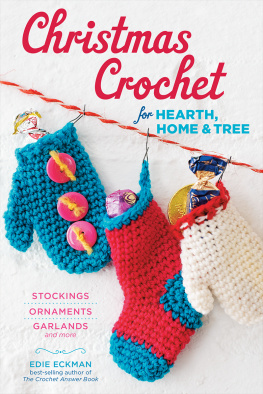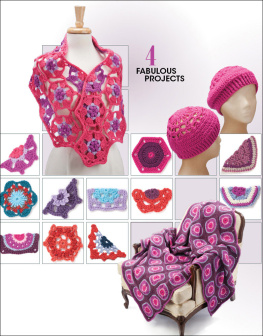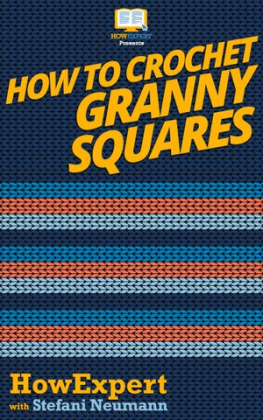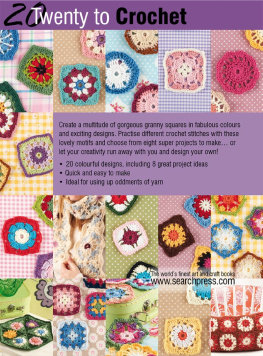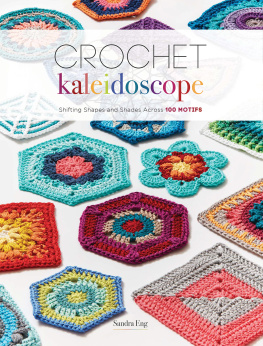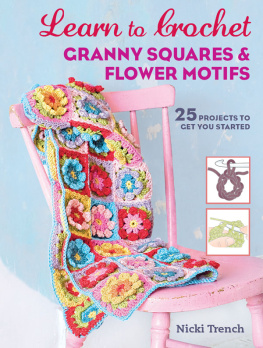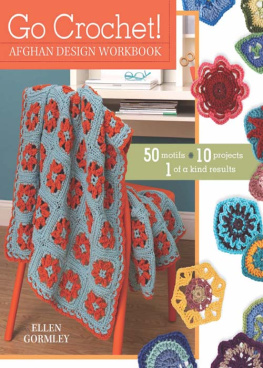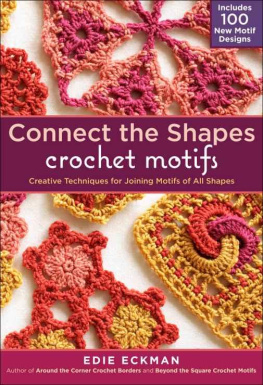BEYOND THE SQUARE
Crochet Motifs
144
circles, hexagons, triangles, squares,
and other unexpected shapes
Edie Eckman

For Mom, with Love
The mission of Storey Publishing is to serve our customers by
publishing practical information that encourages
personal independence in harmony with the environment.
Cover design and art direction by Alethea Morrison
Text design by Leslie Anne Charles/LAC Design
Book production and art direction by Cynthia N. McFarland
Cover and interior photography by John Polak Photography
Crochet diagrams by Karen Manthey, with additional diagrams on pages 19497 by Ilona Sherratt
Watercolor illustrations by Yolanda Gonzalez
Indexed by Christine Lindemer, Boston Road Communications
2008 by Edie Eckman
All rights reserved. No part of this book may be reproduced without written permission from the publisher, except by a reviewer who may quote brief passages or reproduce illustrations in a review with appropriate credits; nor may any part of this book be reproduced, stored in a retrieval system, or transmitted in any form or by any means electronic, mechanical, photocopying, recording, or other without written permission from the publisher.
The information in this book is true and complete to the best of our knowledge. All recommendations are made without guarantee on the part of the author or Storey Publishing. The author and publisher disclaim any liability in connection with the use of this information. For additional information, please contact Storey Publishing, 210 MASS MoCA Way, North Adams, MA 01247.
Storey books are available for special premium and promotional uses and for customized editions. For further information, please call 1-800-793-9396.
Printed in China by Dai Nippon Printing
10 9 8 7 6 5 4 3 2 1
LIBRARY OF CONGRESS CATALOGING-IN-PUBLICATION DATA
Eckman, Edie.
Beyond-the-square crochet motifs / Edie Eckman.
p. cm.
Includes index.
ISBN 978-1-60342-039-6 (hardcover with concealed wire-o : alk. paper)
1. CrochetingPatterns. I. Title.
TT820.E347 2008
746.434dc22
2008018090
CONTENTS
Imagine!
A single crocheted motif can be a thing of beauty, a study in geometry, or both at once. It can be a way to express your creativity or just a frugal way to use up small bits of yarn. It can stand on its own or be used as an embellishment on a purchased item. Combining motifs allows you to make a cozy afghan or a beautiful garment.
A motif can be a square, a hexagon, a circle, or almost any shape you can imagine. It can be light and lacy, dark and solid, or three-dimensional. It can be made in a single color to show off an interesting texture, or stitched in a myriad of complementary or contrasting colors.
A motif gives near-instant gratification: It is quickly stitched and gauge doesnt usually matter. Even a novice crocheter can successfully finish a simple design.
As easy as the actual stitching may be, crochet terminology can be confusing. This is because there are so many options for where to put the hook and so many different stitch combinations. Worldwide, many crocheters interpret instructions depicted only in symbols, using almost no text. The Japanese, in particular, have perfected the art of presenting the patterns for their beautiful handwork using only graphics. This means that if we take the time to learn and understand symbol crochet, we can follow any pattern, no matter what the language of origin; we dont have to read Japanese. Charts make it clear where each stitch goes, showing the relationship of stitches to each other.


Of course, each individual learns in his or her own way, and sometimes a well-placed word is exactly what you need to understand something. For that reason, standard written crochet instructions accompany each chart in this book. Use whichever type of instruction suits you best, or use a combination. Regardless of which format you normally prefer symbols or text you might use this opportunity to stretch your comfort level by attempting a new skill. If you usually follow text instructions, cover up the text and see how you manage using just the charts. If you are already an avid chart-follower, cover the chart and try following the text alone.
A large part of crocheting involves judgment calls: where exactly to put the hook, which colors to use, which finishing techniques to use. The more you know, the more options you have when its time to make these decisions. The first section, Crochet Motif Workshop, contains information that will help you to hone your understanding of motif-making, troubleshoot problems, learn tips to improve your stitching, and design your own motifs. If you prefer, you can just read the Quick-Start Guide and then skip straight to stitching any of the motifs in the book.
A word of warning is in order: Crocheting motifs can be addictive. Once you begin to create these little works of art, exploring the possibilities afforded by playing with shape, color, and texture, youll find it hard to stop!
QUICK-START GUIDE
Getting started. Unless otherwise stated, all motifs begin with a sliding loop (see page 10).
How to make the stitches. See page 198 for descriptions of crochet stitches.
Understanding rounds. Symbol charts are shown in two (or more) colors, indicating alternate rounds. Round numbers appear at the beginning of each round.
Multicolor motifs. Most motifs are written as if they are to be stitched using one color, without breaking the yarn, and using techniques familiar to American crocheters. However, many of the samples shown have been stitched using multiple colors. Refer to the accompanying notes to see what colors were used on which rounds. Refer to for tips on changing colors.
Special techniques. As you study photographs of the motifs, youll notice that many were stitched using one or more of the special tips and tricks covered in . For best results, incorporate these techniques into your crocheting repertoire.
Crochet Motif
WORKSHOP

Motifs can be stitched in an almost infinite number of variables: You can work with different color combinations, move the beginning of a round, or change the way you begin and end rounds. These intriguing options make it difficult to incorporate every possibility into each instruction or chart in this book. For that reason, Ive presented these instructions and charts in more or less standard crochet style in most cases, as if it will be stitched in a single color. Where the examples are stitched in multiple colors, however, Ive indicated which rounds were worked in which colors so that you can duplicate the color placement if you wish.
Once you have digested this chapter, youll find that youll want to make changes or improvements to the standard technique presented in the instructions. Bravo!


